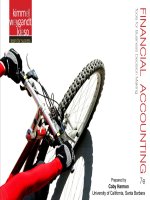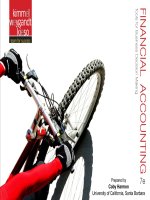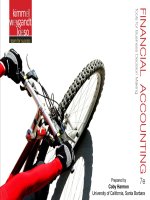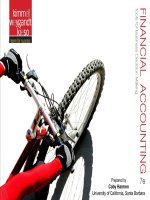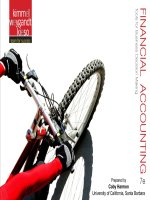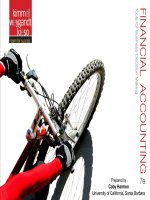Managerial accounting tool for business decision making chapter 03
Bạn đang xem bản rút gọn của tài liệu. Xem và tải ngay bản đầy đủ của tài liệu tại đây (1.09 MB, 57 trang )
Chapter
3-1
CHAPTER 3
PROCESS
COSTING
Managerial Accounting, Fifth Edition
Chapter
3-2
Study
Study Objectives
Objectives
Chapter
3-3
1.
Understand who uses process cost systems.
2.
Explain the similarities and differences between
job order and process cost systems.
3.
Explain the flow of costs in a process cost
system.
4.
Make the journal entries to assign
manufacturing costs in a process cost system.
Study
Study Objectives
Objectives
Chapter
3-4
5.
Compute equivalent units.
6.
Explain the four steps
necessary to prepare a
production cost report.
7.
Prepare a production cost
report.
Preview
Preview of
of Chapter
Chapter
Process cost accounting
focuses on the processes
involved in mass-producing
products that are identical
or very similar in nature.
In contrast, job order cost
accounting focuses on the
individual job.
Chapter
3-5
Process
Process Costing
Costing
Nature
Natureof
of
Process
ProcessCost
Cost
Systems
Systems
Uses
Similarities and
differences
Process cost flow
Assigning
manufacturing
costs
Equivalent
Equivalent
Units
Units
Weightedaverage method
Refinements
Production cost
report
Comprehensive
Comprehensive
Example
Exampleof
of
Process
Process
Costing
Costing
Physical units
Equivalent units of
production
Unit production costs
Cost reconciliation
schedule
Production cost report
Costing systems –
Final comments
Chapter
3-6
Nature
Nature of
of Process
Process Cost
Cost Systems
Systems
Use to apply costs to similar products that are
mass produced in a continuous fashion.
Examples include the production of Ice Cream,
Cereal, Paint, and Soft Drinks.
Once started, production continues until product
is completed; processing is the same for the
entire run.
Illustration 3-1
Chapter
3-7
LO 1: Understand who uses process cost systems.
Comparison
Comparison of
of Products
Products Produced
Produced
Under
Under Process
Process and
and Job
Job Order
Order Cost
Cost Systems
Systems
Illustration 3-2
Chapter
3-8
LO 1: Understand who uses process cost systems.
Let’s
Let’s Review
Review
Which of the following items is not a characteristic
of a process cost system?
a. Once production begins, it continues until the
finished product emerges.
emerges
b. The focus is on continually producing homogenous
(identical) products.
c.
When the finished product emerges, all units
have precisely the same amount of materials,
labor, and overhead.
d. The products produced are heterogenous
(different) in nature.
Chapter
3-9
LO 1: Understand who uses process cost systems.
Job
Job Order
Order Cost
Cost and
and Process
Process Cost
Cost Flow
Flow
Job Order Cost Systems
Chapter
3-10
Process Cost Systems
Costs are assigned to each
job.
Costs are tracked through a
series of connected
manufacturing processes or
departments.
Products have unique
characteristics.
Products are uniform or
relatively homogeneous and
produced in a large volume.
LO 2: Explain the similarities and differences between
job order cost and process cost systems.
Job
Job Order
Order Cost
Cost vs
vs Process
Process Cost
Cost Flow
Flow
Illustration 3-3
Chapter
3-11
LO 2: Explain the similarities and differences between
job order cost and process cost systems.
Similarities
Similarities and
and Differences
Differences in
in Cost
Cost Systems
Systems
Similarities
Both costing systems track the three manufacturing cost
elements: direct materials, direct labor, and
manufacturing overhead.
The accumulation of costs is the same in both systems.
Flow of costs are assigned to the same general ledger
accounts in both costing systems.
However, the methods of assigning the costs
differ significantly.
Chapter
3-12
LO 2: Explain the similarities and differences between
job order cost and process cost systems.
Similarities
Similarities and
and Differences
Differences in
in Cost
Cost Systems
Systems
Differences
The number of Work in Process Inventory accounts:
Job Order – uses only one work in process account.
Process - uses multiple work in process accounts.
Documents used to track costs
Job Order - charges to individual jobs and summarizes on
job cost sheets.
Process – summarizes in production cost reports for each
department.
Chapter
3-13
LO 2: Explain the similarities and differences between job
order and process cost systems.
Similarities
Similarities and
and Differences
Differences in
in Cost
Cost Systems
Systems
Differences
The point at which costs are totaled:
Job Order – totaled when job is completed.
Process - totaled at end of period of time.
Unit cost computation:
Job Order – total cost per job divided by units in job.
Process – total manufacturing costs for the period divided
by units produced during the period.
Chapter
3-14
LO 2: Explain the similarities and differences between job
order and process cost systems.
Major
Major Differences
Differences Between
Between Job
Job Order
Order and
and
Process
Process Cost
Cost Systems
Systems
Illustration 3-4
Chapter
3-15
LO 2: Explain the similarities and differences between
job order and process cost systems.
Let’s
Let’s Review
Review
Indicate which of the following statements is not correct:
a.
Both a job order and a process cost system track the
same three manufacturing cost elements – direct
materials, direct labor, and manufacturing overhead.
b.
A job order cost system uses only one work in process
account, whereas a process cost system uses multiple
work in process accounts.
c.
Manufacturing costs are accumulated the same way in a
job order and in a process cost system.
d.
Manufacturing costs are assigned the same way in a job
order and in a process cost system.
Chapter
3-16
LO 2: Explain the similarities and differences between
job order cost and process cost systems.
Process
Process Cost
Cost Flows
Flows Illustrated
Illustrated
Example – Tyler Company
Maker of automatic can openers.
Manufacturing consists of two processes:
Machining – raw materials are shaped, honed, and
drilled.
Assembly – parts assembled and packaged.
Materials, labor, and manufacturing overhead
added in both departments.
Chapter
3-17
LO 3: Explain the flow of costs in a process cost system.
Process
Process Cost
Cost Flows
Flows Illustrated
Illustrated
Example – Tyler Company
Illustration 3-5
Chapter
3-18
LO 3: Explain the flow of costs in a process cost system.
Assignment
Assignment of
of Manufacturing
Manufacturing Costs
Costs
Accumulation of materials, labor, and overhead
costs is the same as in job order costing.
Debit Raw Materials Inventory for purchases of
raw materials.
Debit Factory Labor for factory labor cost as
incurred.
Debit Manufacturing Overhead for overhead costs
as incurred.
However, assignment of the three manufacturing
cost elements to Work in Process is different.
Chapter
3-19
LO 3: Explain the flow of costs in a process cost system.
Assignment
Assignment of
of Manufacturing
Manufacturing Costs
Costs
Materials
A process cost system requires fewer material
requisition slips than a job order cost system.
Materials are used for processes and not specific jobs.
Requisitions are for larger quantities of materials .
The journal entry to record materials used:
Chapter
3-20
LO 4: Make the journal entries to assign manufacturing
costs in a process cost system.
Assignment
Assignment of
of Manufacturing
Manufacturing Costs
Costs
Factory Labor Costs
Time tickets can be used in both systems.
The labor cost chargeable to a process can also be obtained
from the payroll register or departmental payroll
summaries.
The journal entry to record factory labor costs:
Chapter
3-21
LO 4: Make the journal entries to assign manufacturing
costs in a process cost system.
Assignment
Assignment of
of Manufacturing
Manufacturing Costs
Costs
Manufacturing Overhead Costs
Objective of assigning overhead –
Allocate overhead to departments on an
objective and equitable basis.
Use the activity that “drives”
or causes the costs.
Machine time used Primary driver in continuous manufacturing
operations.
Chapter
3-22
LO 4: Make the journal entries to assign manufacturing
costs in a process cost system.
Assignment
Assignment of
of Manufacturing
Manufacturing Costs
Costs
Manufacturing Overhead Costs
The entry to allocate overhead to the two processes is:
Chapter
3-23
LO 4: Make the journal entries to assign manufacturing costs
in a process cost system.
Assignment
Assignment of
of Manufacturing
Manufacturing Costs
Costs
Entries to Transfer Costs Through System
Monthly entry to transfer goods to next department:
Entry to transfer completed goods to Finished Goods Inventory:
Entry to record Cost of Goods Sold at the time of sale:
Chapter
3-24
LO 4: Make the journal entries to assign manufacturing costs
in a process cost system.
Let’s
Let’s Review
Review
In making the journal entry to assign raw materials
costs, a company:
a.
Debits Finished Goods Inventory.
b. Often debits two or more work in process
accounts.
c.
Generally credits two or more work in
process accounts.
d. Credits Finished Goods Inventory.
Chapter
3-25
LO 4: Make the journal entries to assign manufacturing costs
in a process cost system.

